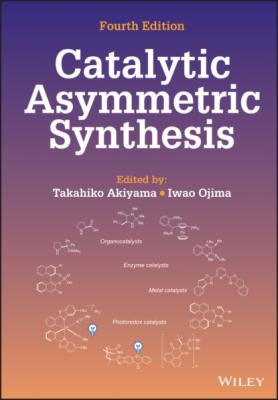Catalytic Asymmetric Synthesis. Группа авторов
Чтение книги онлайн.
Читать онлайн книгу Catalytic Asymmetric Synthesis - Группа авторов страница 33

Figure 1.6. Diarylprolinol silyl ether in this study.
Scheme 1.3. The reaction mechanism of the Diels‐Alder reaction.
Scheme 1.4. The reaction mechanism of the Michael reaction.
1.4.3. Diels‐Alder Type Reaction
The Friedel‐Craft reaction belongs to the Diels‐Alder type set of reactions, and pyrroles, indoles, and aniline react readily with α,β‐unsaturated aldehydes in the presence of MacMillan’s catalyst to afford the products with excellent enantioselectivity (Eq. 1.18) [40]. [3+2] Nitrone cycloaddition also belongs to this type of reaction [41].
1.4.4. Michael Reaction
Active methylene compounds such as nitroalkanes (Eq. 1.19), malonates, and β‐keto esters are suitable Michael donors in the Michael reaction using α,β‐unsaturated aldehydes as a Michael acceptor, catalyzed by diphenylprolinol silyl ether catalyst [42].
Oximes, such as benzaldehyde oxime, also act as suitable Michael donors to afford β‐hydroxy carbonyl compounds after hydrogenolysis (Eq. 1.20) [43]. Given that asymmetric oxy‐Michael reactions are difficult because of the facile retro‐Michael reaction, this two‐step reaction is synthetically useful.
Thiol is also a good Michael donor and chiral β‐thio aldehydes were obtained with excellent enantioselectivity [44].
Aza‐Michael reactions were also reported using thiazoles, tetrazoles, and succinimides, and the products were generated with excellent enantioselectivity [45].
Construction of a C–P bond by the Michael reaction was reported. Asymmetric hydrophosphination proceeded by a reaction of diphenylphosphine and α,β‐unsaturated aldehydes catalyzed by diarylprolinol silyl ether (Eq. 1.21) [46].
Nonactivated ketones such as cyclohexanone are also employed as Michael donors in the reaction of α,β‐unsaturated aldehydes catalyzed by a combination of diphenylprolinol silyl ether and hydroxyproline (or pyrrolidine), to afford the Michael products with excellent enantioselectivity (Eq. 1.22) [47]. The key nucleophile is not an enamine but an enolate, which is generated from a secondary amine by combination with p‐nitrophenol (Eq. 1.23) [48].
1.5. DOMINO REACTION
1.5.1. Introduction of Domino (Cascade and Tandem) Reactions
Domino reactions offer a powerful way to construct complex structures in a single reaction vessel; each reaction occurs as a consequence of the intermediates generated in previous steps without changing any reaction conditions [49]. Most of the asymmetric domino reactions are composed of two reactions occurring one after the other. Organocatalysts can also be effective in domino reactions [50]. List [51], MacMillan [52], and Jørgensen [44] reported the domino iminium/enamine reaction at the same time in 2005. List reported conjugate reduction−Michael cyclization of enal enones, in which treatment of the enal enone with Hantzsch dihydropyridine in the presence of a catalytic amount of MacMillan’s catalyst provided cyclic keto aldehydes with excellent enantioselectivity (Eq. 1.24). MacMillan reported an iminium/enamine domino reaction employing several nucleophiles and electrophiles catalyzed by MacMillan’s catalyst (Eq. 1.25). Jørgensen reported that a domino reaction of conjugate addition of thiol and amination, which was catalyzed by diarylprolinol silyl ether, afforded 1,2‐aminothiol derivatives in nearly optically pure form (Eq. 1.26).
1.5.2.